Feathers are our most taken for granted lures. Yet, they are one of the most versatile capable of taken the majority of predatory species including specimens.
Feathers has also become a loose term during the past decade with plastic and rubber moulding processes making the production of tiny lifelike rubber fish bodies becoming cheap and therefore widely used.
Because feathers are mainly associated with mackerel fishing, it is assumed that any old colour and size will do, but feather patterns and colours are just as critical if you aim to get the best from your lures.
TRUE MACKEREL FEATHERS
The traditional mackerel feathers were, and still are, made from hens and cock hackles, mostly dyed a variety of yellow, green, red and orange, and mounted on spade end hooks with a tinned or plated finish. Usually in strings of four or six lures.
These prove ideal for taking large numbers of baitfish quickly, that is providing the mackerel shoals are dense enough to make the fishing easy. In addition, they can be used over reefs for smaller pollack and coalfish. Where they fall down is in both the hook patterns used, and often the length of feathers mounted on the hooks.
The typical feather hook is sized a little too large for mackerel, mainly being about a size 1 or 1/0 equivalent upto a 3/0. Consider the size of a mackerels mouth and you'll agree that a smaller size 4 hook will catch more fish. Also, the wire gauge on the hooks is too big. The argument about mackerel hooks having to take severe abuse does not stand up because the feathers fall apart after a few sessions anyway. Fish are often hooked and lost because the point of the hook needs heavy pressure to sink it. Adding to the penetration problem are the barbs which are too big as a result of the wire gauge used.
If the length of the feather used is too long and extends beyond the bend of the hook, mackerel can't get the lure in their mouth and can be felt to frequently "nip" at the feathers end and fail to be hooked. This is borne out by the small whitebait about 1in long which are the main stomach contents of summer mackerel. Many feathers used on pre built mackerel traces are twice this length.
Coloured feathers are okay if the water is very clear and mackerel just sub surface, but catch less well at depth and when the water is still carrying colour after recent storms. Remember, mackerel are a sight feeder first and foremost.
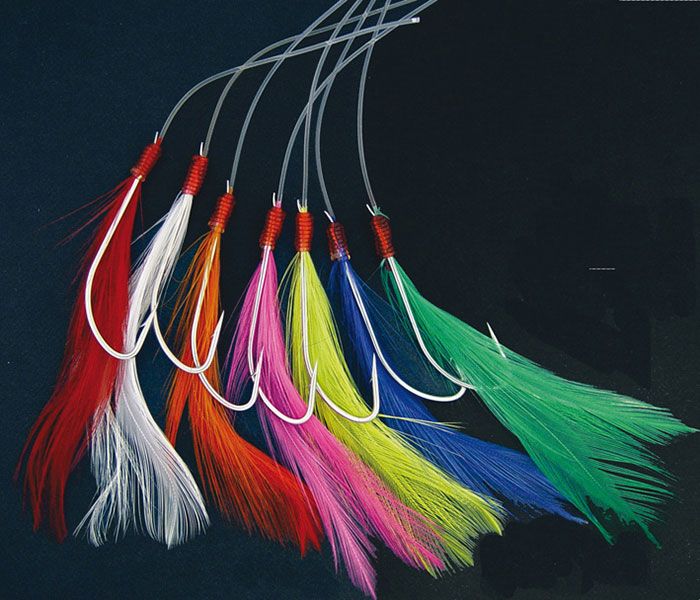
RAINBOW RIBBON LURES
These are similar to standard mackerel feathers, but use florists coloured ribbon cut in thin strips and whipped to the hook shank. They suffer from the same problems as the mackerel feathers with hooks too large and thick in the wire, plus the ribbon extends too far beyond the bend of the hook and you miss fish again.
You can cut the ribbon shorter of course, but the ribbon frays and may split as far as the whipping knot, though this actually makes the lure more attractive (until the ribbon strands pull apart) and natural looking in the water.
Ideal conditions for this type are clear water and mackerel working down to depths of 50ft, no more, for peak results. They also take coalies and pollack over reefs and rough ground.
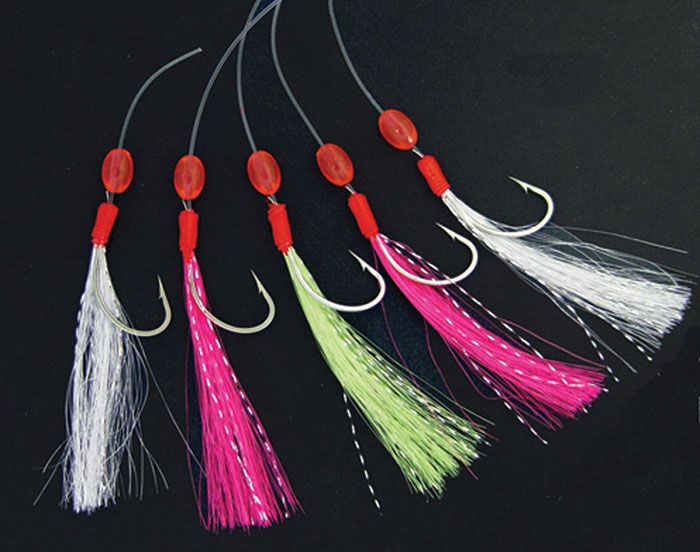
TINSEL TYPE LURES
Simple construction with tubed tinsel being pushed up over the shank of the hook and whipped into place. What tends to happen is that the unwhipped end at the hook bend will quickly unravel and soon destroys the lures main appeal. A dab of superglue helps keep the lure working longer.
The thin profile of the tinsel tube and hook make the lure size the ideal target for mackerel, and the silver flashes the tinsel gives off when jigged up and down represents a shoal of darting fish extremely well. Thanks to these reflections these tinsel lures work deeper down than standard feathers and catch fish travelling in bands at 80ft early in the season. Also, lure for lure, they catch three times as many mackerel as the feathers do.
The smaller tinsel lures also pick up herring and even pilchards down in the southwest and west, and prove deadly again for pollack and coalies, also gurnards over clean sand, and launce sandeels, though the majority of these are foul hooked but still attracted by the tinsels flash.
Some tinsel rigs use a flattened ribbon. Extremely effective, even bass will hit them during the silly season of mid July and early August, but trim the length down again to roughly the length of the hook shank.
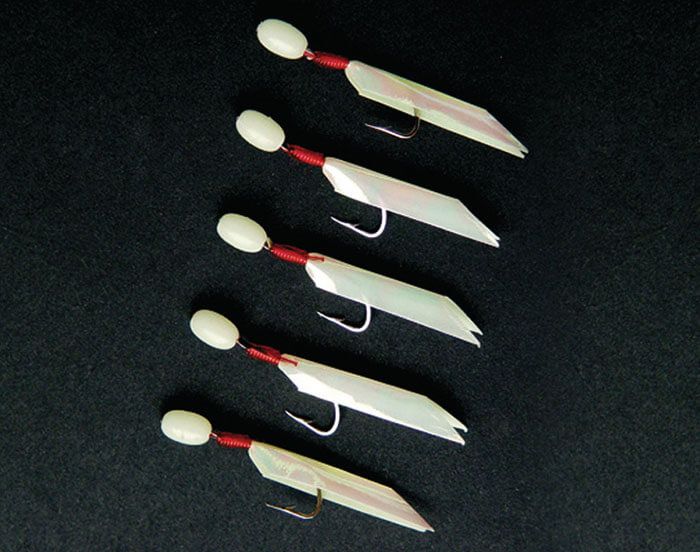
PLASTIC SHRIMP RIGS
Fishing with hokkai Most famous of these are the Hokkai pattern. These use a short, hollow, fluorescent yellow soft plastic body with an eye imprinted on it. The plastic body is half the length of the hook shank, which has silver ribbon and long hackles whipped to it, the body being pushed over this to add both attraction qualities and protection to the feather and whipping.
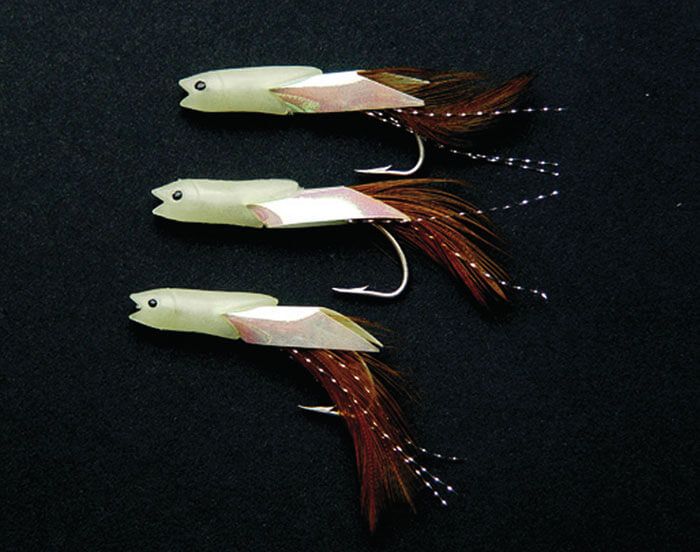
The knack with these light intensifying lures is to either expose them to direct sunlight or to a torch just prior to dropping down to fish. This fluorescent glow and the flash of the ribbon and hook again gives the impression of small baitfish twisting and turning as they feed and stirring floating plankton into life.
Some of these shrimp patterns are made on smaller size 4 hooks and these prove the best for mackerel, herring, gurnards and launce. The bigger hook sizes of 4/0 are one of the best codling and pollack killers over rough ground there is, and even over deep water wrecks the Hokkai and it's many copies will take all sizes of pollack and coalies, plus occasional cod and ling.
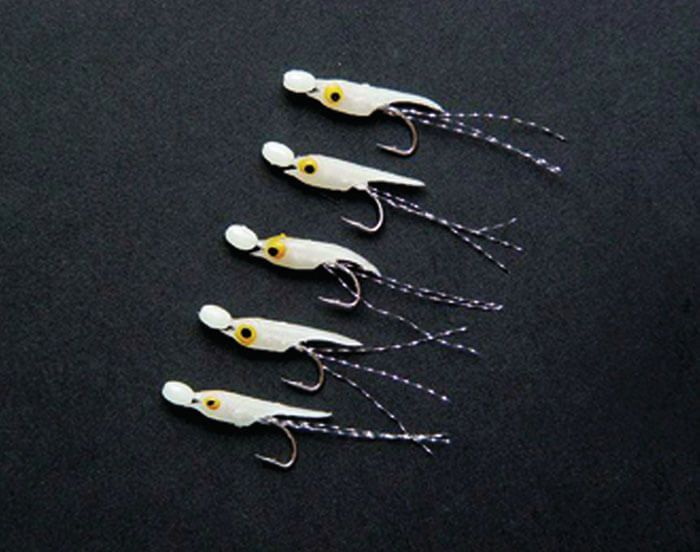
The bigger sized Hokkai's and some of the similar rig lures have a fluorescent bead infront of the plastic body which actual makes the target size a fraction bigger when working deep water, so watch out for these when buying this type of lure for deeper work.
LUMINOUS WING LURES
These are a derivative of the standard ribbon patterns, but use a luminous ribbon. A much better taker of fish than standard ribbon types, but again, tend to have the length of ribbon extending too far beyond the hook.
The best of these use a smaller chromed hook which adds attraction to the lure, but also a red securing whipping and a luminous tapered bead that looks like a head when drawn through the water.
The ribbon can quickly pull apart, but superglue prolongs life, and the lures are especially good for pollack, codling and gurnards, plus jumbo mackerel working the seabed later in the season.
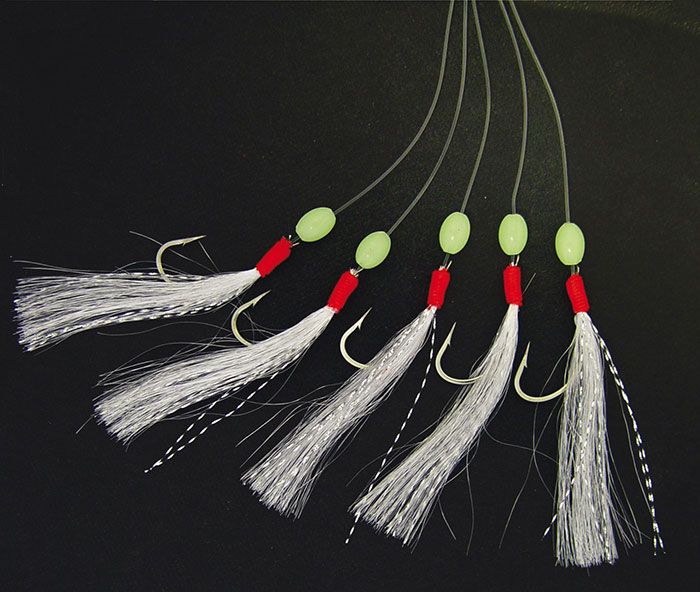
TUBE LURES
The simplest of all feather type rigs with red or yellow, sometimes luminous tubing being pushed over the hook shank and over the hooks eye to hold it in place.
On tiny size 8 hooks these will take sandeels, herrings, pilchards and mackerel. Bigger sizes hook pollack and coalies, plus whiting, gurnards and codling. Easy to make lures like these are ideal for shore fishing when collecting mackerel for the freezer.
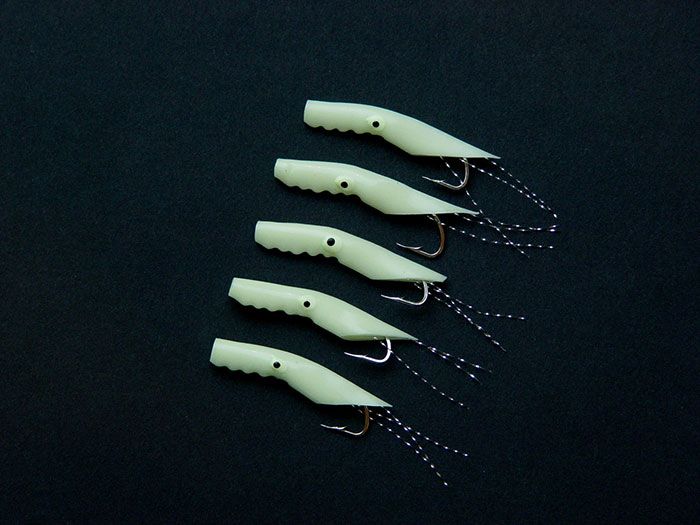
COD FEATHERS
Too often these are sold in strings of six lures. This is too many, three being a better compromise considering that you could easily hit three 5lb fish at once over reefs, or three doubles over wrecks etc.
They are exactly the same as standard mackerel feathers, but use a size 4/0 hook. With cod having big mouths and being quite capable of swallowing whole fish in one, the length of the feather past the hook becomes much less important. The overall feather and hook length needs ideally to be about 3in.
Whilst cod feathers will catch cod on their own, they are best fished with bait utilising the attraction and scent combination when drifting over reef ground and rocky pinnacles. They also work fished above a small pirk, again over rough ground, and also over deep water wrecks.
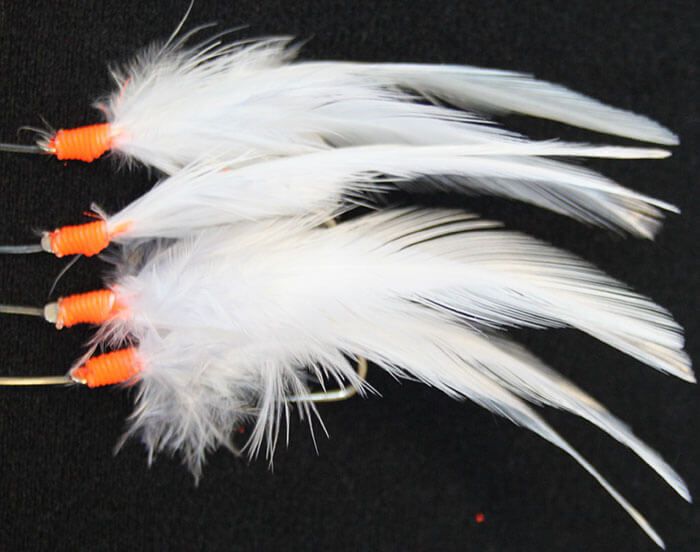
COLOUR CODING
When targeting mackerel, after tinsel type lures, the best feather colour is red, then orange. Yellows, greens, etc, are all secondary colours and catch fewer fish overall.
Pilchard and herring also seem to hit red feathers and tubing far better than all the other colours put together. Launce sandeel hit both red and white colours, rarely yellow and never green.
Going up in lure size, red is by far the best for reef and wreck pollack, but yellow can be deadly on individual occasions for coalfish. Red and white are the primary colours for autumnal whiting, even when fishing baited feathers.
For cod in both deep and shallow water, then a string of all white feathers is unbeatable. Some so called cod feathers are just oversized mackerel feathers and are not good takers of cod. Stick to white at all times.
Rarely, if ever, do you come across whole strings of just one colour feathers. This is where the home builder can score by creating full strings of red to maximize chances against pollack and mackerel.
One of the best colours to use as a whole string is black, but you can't buy black feathers in the shops. Think how effective black artificial eels and muppets are. It's the very best colour of all for pollack, mackerel, sandeels, bass and even takes occasional wrasse when pollacking.
WHAT TO LOOK FOR WHEN BUYING FEATHERS AND RIGGED LURES
Firstly, monofilament line for mackerel feathers and for rig lures aimed at reef pollack and the like, should be about 50lb breaking strain. In this range, it is less likely to tangle and will stand abuse and abrasion when repeatedly unhooking fish.
Cod feathers for general fishing need to be tied to 60lb line, going up to 80lb when wreck fishing. The same applies to rigs likely to hook double figure pollack etc.
Bought rigs should have all their knots thoroughly tested. Many such rigs are constructed in the Far East where quality can be lacking. This applies especially to the main knots connecting line to swivels and to hooks.
The quality of supplied swivels is also very suspect. Many are the cheapest available barrel swivels that sport wire eyes that will bend over easily inside the main body and snap without warning. Bear this in mind when buying feathers for casting from the beach.
Given the choice, go for hooks with eyes. These are rarely used on feather rigs, but some companies do use them which allows you to re-tie hooks on quickly and reliably extending the life of the feathers. Spade end hooks are most frequently used, but knots are unreliable and the spade end can cut through the mono and lose you fish.
If possible, choose lures tied to medium wire chromed or gold plated hooks with small barbs and short thin points to maximize hook ups. If you have to use thicker gauged hooks, slim the profile of the point and barb down with a file or stone to get better penetration. It makes a big difference, especially when after mackerel and cod.
Feathers has also become a loose term during the past decade with plastic and rubber moulding processes making the production of tiny lifelike rubber fish bodies becoming cheap and therefore widely used.
Because feathers are mainly associated with mackerel fishing, it is assumed that any old colour and size will do, but feather patterns and colours are just as critical if you aim to get the best from your lures.
TRUE MACKEREL FEATHERS
The traditional mackerel feathers were, and still are, made from hens and cock hackles, mostly dyed a variety of yellow, green, red and orange, and mounted on spade end hooks with a tinned or plated finish. Usually in strings of four or six lures.
These prove ideal for taking large numbers of baitfish quickly, that is providing the mackerel shoals are dense enough to make the fishing easy. In addition, they can be used over reefs for smaller pollack and coalfish. Where they fall down is in both the hook patterns used, and often the length of feathers mounted on the hooks.
The typical feather hook is sized a little too large for mackerel, mainly being about a size 1 or 1/0 equivalent upto a 3/0. Consider the size of a mackerels mouth and you'll agree that a smaller size 4 hook will catch more fish. Also, the wire gauge on the hooks is too big. The argument about mackerel hooks having to take severe abuse does not stand up because the feathers fall apart after a few sessions anyway. Fish are often hooked and lost because the point of the hook needs heavy pressure to sink it. Adding to the penetration problem are the barbs which are too big as a result of the wire gauge used.
If the length of the feather used is too long and extends beyond the bend of the hook, mackerel can't get the lure in their mouth and can be felt to frequently "nip" at the feathers end and fail to be hooked. This is borne out by the small whitebait about 1in long which are the main stomach contents of summer mackerel. Many feathers used on pre built mackerel traces are twice this length.
Coloured feathers are okay if the water is very clear and mackerel just sub surface, but catch less well at depth and when the water is still carrying colour after recent storms. Remember, mackerel are a sight feeder first and foremost.

RAINBOW RIBBON LURES
These are similar to standard mackerel feathers, but use florists coloured ribbon cut in thin strips and whipped to the hook shank. They suffer from the same problems as the mackerel feathers with hooks too large and thick in the wire, plus the ribbon extends too far beyond the bend of the hook and you miss fish again.
You can cut the ribbon shorter of course, but the ribbon frays and may split as far as the whipping knot, though this actually makes the lure more attractive (until the ribbon strands pull apart) and natural looking in the water.
Ideal conditions for this type are clear water and mackerel working down to depths of 50ft, no more, for peak results. They also take coalies and pollack over reefs and rough ground.

TINSEL TYPE LURES
Simple construction with tubed tinsel being pushed up over the shank of the hook and whipped into place. What tends to happen is that the unwhipped end at the hook bend will quickly unravel and soon destroys the lures main appeal. A dab of superglue helps keep the lure working longer.
The thin profile of the tinsel tube and hook make the lure size the ideal target for mackerel, and the silver flashes the tinsel gives off when jigged up and down represents a shoal of darting fish extremely well. Thanks to these reflections these tinsel lures work deeper down than standard feathers and catch fish travelling in bands at 80ft early in the season. Also, lure for lure, they catch three times as many mackerel as the feathers do.
The smaller tinsel lures also pick up herring and even pilchards down in the southwest and west, and prove deadly again for pollack and coalies, also gurnards over clean sand, and launce sandeels, though the majority of these are foul hooked but still attracted by the tinsels flash.
Some tinsel rigs use a flattened ribbon. Extremely effective, even bass will hit them during the silly season of mid July and early August, but trim the length down again to roughly the length of the hook shank.

PLASTIC SHRIMP RIGS
Fishing with hokkai Most famous of these are the Hokkai pattern. These use a short, hollow, fluorescent yellow soft plastic body with an eye imprinted on it. The plastic body is half the length of the hook shank, which has silver ribbon and long hackles whipped to it, the body being pushed over this to add both attraction qualities and protection to the feather and whipping.

The knack with these light intensifying lures is to either expose them to direct sunlight or to a torch just prior to dropping down to fish. This fluorescent glow and the flash of the ribbon and hook again gives the impression of small baitfish twisting and turning as they feed and stirring floating plankton into life.
Some of these shrimp patterns are made on smaller size 4 hooks and these prove the best for mackerel, herring, gurnards and launce. The bigger hook sizes of 4/0 are one of the best codling and pollack killers over rough ground there is, and even over deep water wrecks the Hokkai and it's many copies will take all sizes of pollack and coalies, plus occasional cod and ling.

The bigger sized Hokkai's and some of the similar rig lures have a fluorescent bead infront of the plastic body which actual makes the target size a fraction bigger when working deep water, so watch out for these when buying this type of lure for deeper work.
LUMINOUS WING LURES
These are a derivative of the standard ribbon patterns, but use a luminous ribbon. A much better taker of fish than standard ribbon types, but again, tend to have the length of ribbon extending too far beyond the hook.
The best of these use a smaller chromed hook which adds attraction to the lure, but also a red securing whipping and a luminous tapered bead that looks like a head when drawn through the water.
The ribbon can quickly pull apart, but superglue prolongs life, and the lures are especially good for pollack, codling and gurnards, plus jumbo mackerel working the seabed later in the season.

TUBE LURES
The simplest of all feather type rigs with red or yellow, sometimes luminous tubing being pushed over the hook shank and over the hooks eye to hold it in place.
On tiny size 8 hooks these will take sandeels, herrings, pilchards and mackerel. Bigger sizes hook pollack and coalies, plus whiting, gurnards and codling. Easy to make lures like these are ideal for shore fishing when collecting mackerel for the freezer.

COD FEATHERS
Too often these are sold in strings of six lures. This is too many, three being a better compromise considering that you could easily hit three 5lb fish at once over reefs, or three doubles over wrecks etc.
They are exactly the same as standard mackerel feathers, but use a size 4/0 hook. With cod having big mouths and being quite capable of swallowing whole fish in one, the length of the feather past the hook becomes much less important. The overall feather and hook length needs ideally to be about 3in.
Whilst cod feathers will catch cod on their own, they are best fished with bait utilising the attraction and scent combination when drifting over reef ground and rocky pinnacles. They also work fished above a small pirk, again over rough ground, and also over deep water wrecks.

COLOUR CODING
When targeting mackerel, after tinsel type lures, the best feather colour is red, then orange. Yellows, greens, etc, are all secondary colours and catch fewer fish overall.
Pilchard and herring also seem to hit red feathers and tubing far better than all the other colours put together. Launce sandeel hit both red and white colours, rarely yellow and never green.
Going up in lure size, red is by far the best for reef and wreck pollack, but yellow can be deadly on individual occasions for coalfish. Red and white are the primary colours for autumnal whiting, even when fishing baited feathers.
For cod in both deep and shallow water, then a string of all white feathers is unbeatable. Some so called cod feathers are just oversized mackerel feathers and are not good takers of cod. Stick to white at all times.
Rarely, if ever, do you come across whole strings of just one colour feathers. This is where the home builder can score by creating full strings of red to maximize chances against pollack and mackerel.
One of the best colours to use as a whole string is black, but you can't buy black feathers in the shops. Think how effective black artificial eels and muppets are. It's the very best colour of all for pollack, mackerel, sandeels, bass and even takes occasional wrasse when pollacking.
WHAT TO LOOK FOR WHEN BUYING FEATHERS AND RIGGED LURES
Firstly, monofilament line for mackerel feathers and for rig lures aimed at reef pollack and the like, should be about 50lb breaking strain. In this range, it is less likely to tangle and will stand abuse and abrasion when repeatedly unhooking fish.
Cod feathers for general fishing need to be tied to 60lb line, going up to 80lb when wreck fishing. The same applies to rigs likely to hook double figure pollack etc.
Bought rigs should have all their knots thoroughly tested. Many such rigs are constructed in the Far East where quality can be lacking. This applies especially to the main knots connecting line to swivels and to hooks.
The quality of supplied swivels is also very suspect. Many are the cheapest available barrel swivels that sport wire eyes that will bend over easily inside the main body and snap without warning. Bear this in mind when buying feathers for casting from the beach.
Given the choice, go for hooks with eyes. These are rarely used on feather rigs, but some companies do use them which allows you to re-tie hooks on quickly and reliably extending the life of the feathers. Spade end hooks are most frequently used, but knots are unreliable and the spade end can cut through the mono and lose you fish.
If possible, choose lures tied to medium wire chromed or gold plated hooks with small barbs and short thin points to maximize hook ups. If you have to use thicker gauged hooks, slim the profile of the point and barb down with a file or stone to get better penetration. It makes a big difference, especially when after mackerel and cod.

